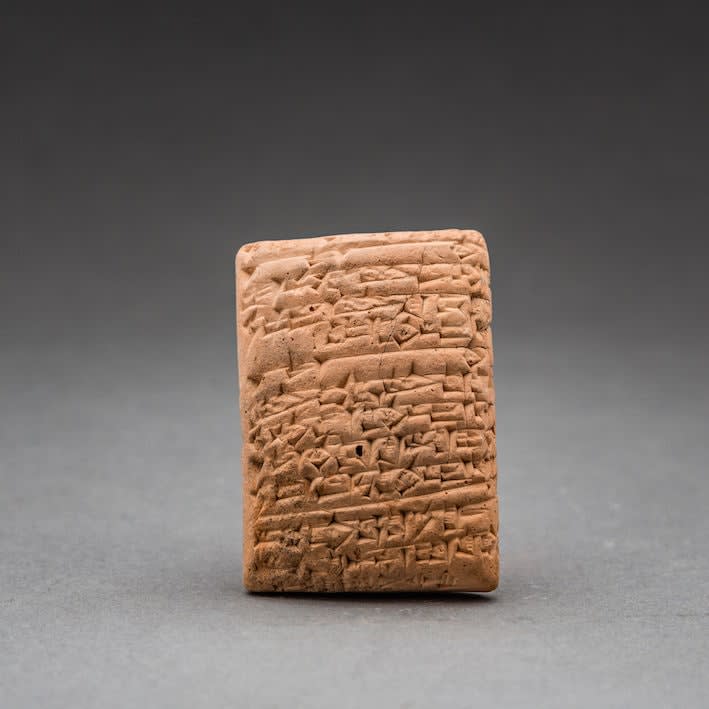Sumerian Cuneiform Tablet, 2027 BCE
1.65 x 3.15
AM.0102
Further images
Sumerian cuneiform is one of the earliest known forms of written expression. First appearing in the 4th millennium BC in what is now Iraq, it was dubbed cuneiform (‘wedge-shaped’) because...
Sumerian cuneiform is one of the earliest known forms of written expression. First appearing in the 4th millennium BC in what is now Iraq, it was dubbed cuneiform (‘wedge-shaped’) because of the distinctive wedge form of the letters, created by pressing a reed stylus into wet clay. Early Sumerian writings were essentially pictograms, which became simplified in the early and mid 3rd millennium BC to a series of strokes, along with a commensurate reduction in the number of discrete signs used (from c.1500 to 600). The script system had a very long life and was used by the Sumerians as well as numerous later groups – notably the Assyrians, Elamites, Akkadians and Hittites – for around three thousand years. Certain signs and phonetic standards live on in modern languages of the Middle and Far East, but the writing system is essentially extinct. It was therefore cause for great excitement when the ‘code’ of ancient cuneiform was cracked by a group of English, French and German Assyriologists and philologists in the mid 19th century AD. This opened up a vital source of information about these ancient groups that could not have been obtained in any other way.
Cuneiform was used on monuments dedicated to heroic – and usually royal – individuals, but perhaps its most important function was that of record keeping. The palace-based society at Ur and other large urban centres was accompanied by a remarkably complex and multifaceted bureaucracy, which was run by professional administrators and a priestly class, all of whom were answerable to central court control. Most of what we know about the way the culture was run and administered comes from cuneiform tablets, which record the everyday running of the temple and palace complexes in minute detail, as in the present case. The Barakat Gallery has secured the services of Professor Lambert (University of Birmingham), a renowned expert in the decipherment and translation of cuneiform, to examine and process the information on these tablets. The following is a transcription of his analysis of this tablet:
‘This is a tablet in a perfect state of preservation. It dates to the period of the Third Dynasty of Ur, and is an administrative document listing food issued to official messengers to sustain them on their travels. It covers the foods issued during one month of the second year of the last king of the dynasty, Ibbi-Sin, c. 2027 B.C.
Translation:
2….s, 4 sila of soup: Mr Puzur-Sin, son of the grand vizier. 2 sila of soup: Mr Ur-Nungal, king’s messenger. 2 sila of soup: Mr Ahu-baqar, king’s messenger when they went to call up men to thrash barley. 1 sila of soup: Mr Bu’a, king’s messenger when he went to Der. 1 sila of soup: Mr Atmum, king’s messenger when he went to the commissar of the…men. 1 sila of soup: Mr Lugal-amarku, the…man when he went to Girsu. 1 sila of soup: Mr Dadi-ilishu, the barber when he went for…twigs. Disbursement of the month of Shunigal. Year: the high priestess of Inanna of Uruk was chosen by divination. Left edge: 9th day.
A sila was about .85 of a litre. This tablet is important because it often gives the purpose of the journeys, while previously published tablets of this category merely list the men and their rations without stating why they had to travel for the king.’
Cuneiform was used on monuments dedicated to heroic – and usually royal – individuals, but perhaps its most important function was that of record keeping. The palace-based society at Ur and other large urban centres was accompanied by a remarkably complex and multifaceted bureaucracy, which was run by professional administrators and a priestly class, all of whom were answerable to central court control. Most of what we know about the way the culture was run and administered comes from cuneiform tablets, which record the everyday running of the temple and palace complexes in minute detail, as in the present case. The Barakat Gallery has secured the services of Professor Lambert (University of Birmingham), a renowned expert in the decipherment and translation of cuneiform, to examine and process the information on these tablets. The following is a transcription of his analysis of this tablet:
‘This is a tablet in a perfect state of preservation. It dates to the period of the Third Dynasty of Ur, and is an administrative document listing food issued to official messengers to sustain them on their travels. It covers the foods issued during one month of the second year of the last king of the dynasty, Ibbi-Sin, c. 2027 B.C.
Translation:
2….s, 4 sila of soup: Mr Puzur-Sin, son of the grand vizier. 2 sila of soup: Mr Ur-Nungal, king’s messenger. 2 sila of soup: Mr Ahu-baqar, king’s messenger when they went to call up men to thrash barley. 1 sila of soup: Mr Bu’a, king’s messenger when he went to Der. 1 sila of soup: Mr Atmum, king’s messenger when he went to the commissar of the…men. 1 sila of soup: Mr Lugal-amarku, the…man when he went to Girsu. 1 sila of soup: Mr Dadi-ilishu, the barber when he went for…twigs. Disbursement of the month of Shunigal. Year: the high priestess of Inanna of Uruk was chosen by divination. Left edge: 9th day.
A sila was about .85 of a litre. This tablet is important because it often gives the purpose of the journeys, while previously published tablets of this category merely list the men and their rations without stating why they had to travel for the king.’





